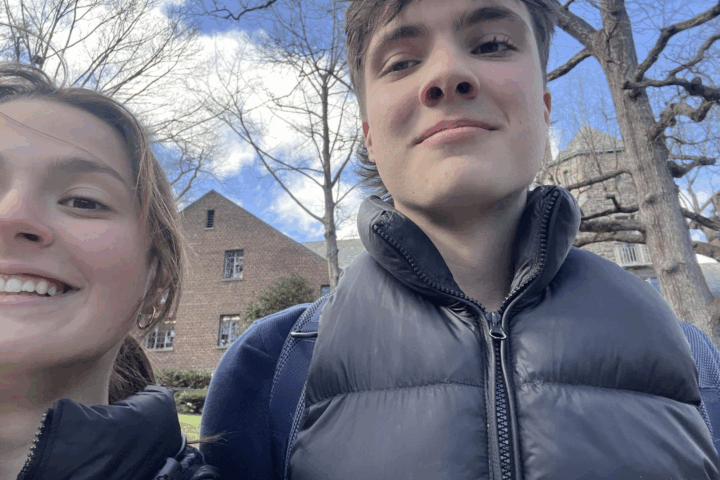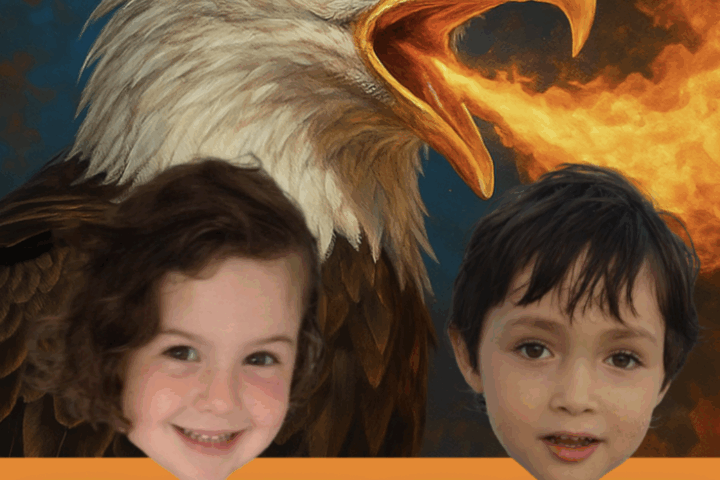
In the background: the whoop of a train whistle, the clash of its wheels against the tracks. In the foreground: the wind’s whistle, softer; leaves rustling in the wind; the ghostly howl of a screech owl, one of twenty-seven bird species that surveil the woods of Riverdale Park, fifty-odd acres of forest bordering the Hudson River at 254th Street in the Bronx, New York. Just one long hill away from the bus stops, supermarkets, semi-urban streets and restaurants of Riverdale, this strangely placed sanctuary is a safe space for so many groups of people and wildlife that make their home in the Northwest Bronx. Accessible to all, providing an escape from the ruckus of the working day, Riverdale Park is the heart and soul of my neighborhood.
This wooded wonderland is where the people of Riverdale go to clear their heads, take a walk with a loved one or a pet, listen to the sounds of nature, or see the beautiful soaring view of the Hudson River and the majestic cliffs of the Palisades in New Jersey. It sits on a bluff over 150 feet above the river.
You can see many different people at Riverdale Park — local families with their dogs, diplomats from the nearby Russian embassy walking through, speaking their guttural language which my grandmother spoke fluently, a father and son playing catch, teens doing service work cleaning the forest ground, Orthodox Jews observing Shabbat. It’s a “people’s park” but without the cache of a Central Park or Prospect Park. It largely goes unseen by the world.
Lynn Roland, who came to Riverdale in 2001 and lives with her husband and two children in an apartment building a five minute drive from Riverdale Park, often runs along the quiet, bumpy trails there. When she first came to the area, she was nervous about the safety of the woods because she heard there was an assault nearby some years earlier. In time, she began to use the wooded area more frequently because she had grown tired of running other paths and wanted to spice up her routine. Soon, the woods became familiar and special: “They are egalitarian and shared by lots of people in the community, but are never so crowded that they don’t feel like an escape of sorts; I recognize people over time and that makes the community feel more warm and meaningful to me.” Roland also appreciates the beauty and uniqueness of the environment and creatures that roam Riverdale Park: “There is something eternal about nature – the interaction of the undergrowth, trees, decay and critters, and knowing it has been there before me and will be there after me. I find that perspective-setting and calming and it makes me feel grateful.”
There was a time when this area wasn’t so egalitarian. In the late 1800’s, wealthy Manhattanites came to Riverdale seeking a place to kick back, hunt, fish, ride horses and enjoy the fresh “country” air. At the same time, in the woods where Riverdale Park stands today, working class and poor people toiled at kilns, foundries and factories, like the Johnson Iron Foundry and the Spuyten Duyvil Rolling Mill Company. The woods were not a place of relaxation and peace for everyone. Rich and poor had two completely different experiences in this forest. For the rich, this was a place for recreation; for the poor, it was a place of hard labor in terrible conditions. Today, there are still economic differences in this area, but the woods provide the opportunity for escape for all. Frederick Olmsted, the designer of parks and natural spaces like Central Park and Prospect Park in NYC as well as several areas in Riverdale, suggests that in urban life we are unconsciously relaxed by the outdoors, that green space helps us get away from busy, blaring noise of cities. Riverdale Park proves Olmsted’s theory by being a place that people go to let loose from distractions, from the constant headaches of traffic and honking and from the stress of work.
In this fast-moving world, we often fail to acknowledge the existence of our neighbors and community. In the woods, people recognize and greet each other and remember each other’s names (and even the names of their pets). During Covid, this kind of connection was rare and difficult to find, but in the woods of Riverdale Park, people were able to walk without masks, socially distanced, and enjoy time together. According to Dr. Cathy Raduns, a longtime Riverdalian who lives in a home a few blocks from the forest, “During Covid the woods became more important because it was a place to feel comfortable, you didn’t have to necessarily wear your mask, and you could walk in some beauty and feel relaxed and so it became even more important here—there were a lot more people here than usual, so it wasn’t as private but we got used to that also.”
Helen Chutorian, my grandmother, age 91, raised her family in Riverdale just one mile down the road from Riverdale Park and now lives in Manhattan. During Covid, elderly people were at extreme risk and became extremely lonely and isolated. Helen came to visit her grandchildren and took a walk with them in Riverdale Park. It was the first time she was able to socialize and remove her mask since quarantine began. She recalls that “at a time so filled with anxiety, spending time in a peaceful, wooded area enabled me to breathe deeply, appreciate the serenity of the space and safely be among other people again.”
Over time these woods could have been chopped down and replaced by highways or highrises, but instead residents made Riverdale Park into a Special Natural Area District, meaning that natural aspects of the area cannot be touched. The high slopes, peeking outcrops of rocks, ponds, grown trees, marshes that feed the aquatic birds are all protected. According to the NYC Parks Department, the forest contains five types of oak — red oak, black oak, white oak, pin oak and chestnut — and also black birch and hickory. Black birch has a thin shape, sideways stripes and is layered, while the hickory is thicker and more solidly layered with bark. The park is well on its way to becoming a “climax” forest meaning descendants of trees will continue to grow under their parents. The older trees are watching the younger trees progress upward right underneath their branches, just like the human parents who take their kids to walk this forest.
Long before the cars and airplanes of today, before the trains, before the Dutch, before the foundries and hospitals, the Lenape Indians lived in and around these serene wooded spaces. They called the area Lenapehoking. Many people know the story that Manhattan was sold by the Lenape people to the Dutch for $26. It is believed today that the Lenape thought it would be shared land. The same situation is thought to have happened in the Bronx. In Riverdale Park, many children will make teepees out of wooden logs and branches. They come from the area, from the Salanter Akiba Riverdale Academy and from the Fieldston Lower School. They build these teepees and see how long they will last, then play in them the same way children play in forts made of boxes and pillows at home. These teepees are ironic because the Lenape people lived in longhouses and wigwams, not teepees. Their longhouses looked like little hills with their half-circular shapes, almost like logs chopped in half and floating across a river of earth. However, in Riverdale Park, archaeologists have found arrowheads and scrapers left behind the Lenape and those who came before them. They roamed these woods; the woods have always welcomed people who sought out space to gather.
Personally, I will never forget the first week I went to Riverdale Park with my dad. We were amazed. I was six years old, bursting with joy and eager to run in circles around the woods. I was with my dog Pumpkin and we fell in love at first sight with the free, calming atmosphere. I built a log house with my dad and we added more and more logs every day. The log house ended up lasting multiple years through snowstorms. I can still picture the sturdy square hut covered in snow, standing tall.
These woods are special for so many families, including Dr. Cathay Raduns and her three boys. For them, the woods were a place of imagination. She remembers how “For years and years, we would talk about the elves that lived in these woods.” Her sons associated the park with fantasy, as if to enter the woods was to cross the threshold into a beautiful dream world, where anything was possible. Truly, anything is possible in Riverdale Park, because Riverdale Park is where people relax and rejoice in their freedom, where our neighbors venture to let their dreams grow taller than trees.





